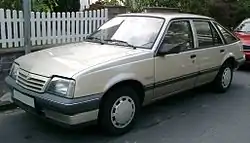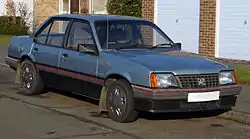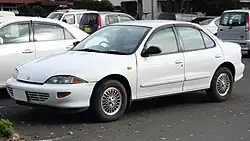General Motors J platform
The General Motors J platform, or J-body, is an automobile platform that was used by General Motors for compact cars from the 1982 to 2005 model years. The third generation of compact cars designed by GM, the J-body marked the introduction of front-wheel drive for its compact model lines, simultaneously replacing the rear-wheel drive H-body and the European U-body platforms, the latter being a stretched version of the original rear-wheel drive T-body. The J-body was marketed as a world car, with GM brands selling versions of the platform in North America, Europe, Australia, and Japan; in markets outside of North America, the model line was packaged as a mid-size car.
| J-body | |
|---|---|
 A 1987 Vauxhall Cavalier, the Vauxhall version of the GM J-body. | |
| Overview | |
| Manufacturer | General Motors |
| Production | 1981–2005 |
| Body and chassis | |
| Class | Compact (North America) Mid-size (Global) |
| Layout | Transverse front-engine, front-wheel drive |
| Body style(s) | 2-door convertible 2-door coupe 2-door notchback sedan 3-door hatchback 4-door sedan 5-door station wagon 5-door hatchback |
| Chronology | |
| Predecessor | GM H platform (RWD) (North America) |
| Successor | GM2900 platform (Europe) GM Delta (North America) |
Outside North America, the use of the J platform was phased out after the 1980s in favor of the Opel-based GM2900 platform. In North America, the introduction of the Saturn S-Series would lead to the consolidation of the J-body to the Chevrolet and Pontiac brands.
Following several major revisions, the J platform remained in use into the 21st century; in June 2005, the final example (a Pontiac Sunfire) was produced. Introduced by Saturn for 2003, the GM Delta platform is the fourth generation of compact cars from General Motors.
Background
The design of the J-car began in 1976.[1] Originally, the J-car was only intended for the Chevrolet and Pontiac brands, but soon thereafter Oldsmobile and Buick were added.[1] At the time, GM-controlled divisions in different parts of the world manufactured totally different rear-wheel drive C-segment cars – the Chevrolet Vega in America, the Vauxhall Cavalier/Opel Ascona in Europe, the Holden Torana in Australia and the Isuzu Florian in Japan. It was decided that a common replacement would be developed to eliminate duplication of engineering effort and ensure parts interchangeability – a practice known as badge engineering or platform-sharing. In November 1979, subsequent to the second fuel crisis and only 14 months before the cars introduction, it was decided to create a Cadillac derivative as well. Aside from a hefty price tag, the hastily developed Cimarron had little to distinguish it from the other J-car offerings.[1]
In continental Europe, the car was sold as the Opel Ascona. In Britain, it was known as the Vauxhall Cavalier. Irrespective of badging, European production of the J-body occurred in plants in Germany, Belgium, and Britain.[2] It was generally well received but was narrowly beaten to the European Car of the Year accolade by the Renault 9. The Vauxhall Cavalier version was particularly successful in Britain, where it was the second best selling car in 1984 and 1985 and managed around 800,000 sales across a seven-year production run.[3] At the time, it set new standards for performance and economy in this size of car in Europe; for instance, the 1.6 petrol engined Cavalier for the British market had a top speed of 105 mph, compared to the 101 mph top speed of the 2.0 petrol engined Ford Cortina – its key competitor for a year until the Ford Sierra was launched in 1982.[2] Due to the exterior dimensions, and the engines offered being in compliance with Japanese regulations, the platform was classed in the favorable "compact" designation allowing the Isuzu Aska to compete with other Japanese made products sold in the domestic market at the time. Isuzu also supplied kits for Holden's J-car version, the Camira.[4], whilst correspondingly - Holden manufactured the GM Family II engines installed in J-body cars manufactured worldwide, and also the station wagon bodywork for the Camira was supplied to Vauxhall in the UK for its estate version of the Cavalier II.
The fourth character in the Vehicle Identification Number for a J-body car is "J".
| Model | MSRP |
|---|---|
| Chevrolet Cavalier CL | $8,137 ($24,675 in 2022 dollars [6]) |
| Pontiac J2000 LE | $7,548 ($22,889 in 2022 dollars [6]) |
| Oldsmobile Firenza LX | $8,080 ($24,502 in 2022 dollars [6]) |
| Buick Skyhawk Limited | $7,931 ($24,050 in 2022 dollars [6]) |
| Cadillac Cimarron | $12,181 ($36,938 in 2022 dollars [6]) |
Development
The platform received two major cosmetic redesigns, in 1988 and a more thorough makeover in 1995, along with major powertrain revisions. The 1995 makeover was only sold in North America, as General Motors subsidiaries in other countries had replaced it (mainly with cars based on the GM2900 platform). This makeover had originally been planned for the 1992 model year when work begain in 1988, but General Motors' bad finances forced them to postpone it twice.[7]
A variety of convertible versions were developed as well, from fully official to purely aftermarket. In all cases, final assembly of convertibles was subcontracted by General Motors; in North America by American Sunroof Corporation (ASC); in Brazil by Envemo and Sulam, and in Europe by Keinath and Hammond & Thiede. Hammond & Thiede's version originated with the Karosseriefabrik Voll, which was taken over by H&T in 1985.[8]
Models
Over its 24-year production run, the GM J platform would be sold under 16 different nameplates (five under the Pontiac brand alone). During the 1980s, a version of the J platform would be marketed by every division of General Motors in North America (with the exception of GMC).
Over 5.8 million of the original (pre-1995 facelift) J-cars were sold in North America.[7] Approximately 10,150,000 GM J platform cars were sold across eleven marques on six continents from 1982 through 1997.[5][9][10][11] Consequently, it is the fifth best selling automobile platform in automotive history.
| Vehicle Name | Years Produced | Body Styles | Notes |
|---|---|---|---|
| North American-market nameplates | |||
| Buick Skyhawk
|
1981[lower-alpha 1]–1989 | 2-door sedan 4-door sedan 3-door hatchback 5-door station wagon (1983–1988) | The 1989 Buick Skyhawk would be the last Buick sold with a manual transmission until 2011. |
| Cadillac Cimarron
|
1981[lower-alpha 1]–1988 | 4-door sedan | The Cadillac Cimarron shared most of its body panels with the Chevrolet Cavalier, becoming one of the most infamous examples of automotive badge engineering. |
| Chevrolet Cavalier
|
1981[lower-alpha 1]–2005 | 2-door sedan 2-door coupe 2-door convertible 4-door sedan 3-door hatchback 5-door station wagon | Longest-produced and best-selling J-body. |
| Oldsmobile Firenza
|
1981[lower-alpha 1]–1988 | 2-door sedan 4-door sedan 3-door hatchback 5-door station wagon (1983-88) | The Oldsmobile Firenza is the shortest-produced version of the J-platform in North America. |
| Pontiac J2000
|
1981[lower-alpha 1]–1982 (J2000) 1983 (2000) 1984 (2000 Sunbird) 1985–1994 (Sunbird) |
2-door sedan 2-door coupe 2-door convertible 4-door sedan 3-door hatchback 5-door station wagon | |
| Pontiac Sunfire
|
1994–2005 | 2-door coupe 2-door convertible 4-door sedan | The Sunfire replaced the Sunbird as part of a major redesign of the J-platform for 1995. |
| |||
| Global-market nameplates | |||
| Chevrolet Monza
|
1982–1996 | 2-door sedan 4-door sedan 3-door hatchback | Produced in Brazil, the Monza is a version of the Opel Ascona.
3-door hatchbacks have different (more upright) rooflines than the North American versions. |
| Holden Camira
|
1982–1989 | 4-door sedan 5-door station wagon | The body of the Camira station wagon served as the basis for the Vauxhall Cavalier wagon in the UK. |
| Isuzu Aska
|
1983–1989 | 4-door sedan | The Aska was sold as a Chevrolet in South America, and briefly as the Holden JJ Camira in New Zealand. |
|
|
1981–1988 |
Opel:
2-door sedan Vauxhall:
2-door sedan | The Ascona/Cavalier are badge-engineered vehicles, with the Opel sold in continental Europe and the Vauxhall sold in Great Britain. Station wagon body panels are derived from the Holden Camira produced in Australia. |
| Toyota Cavalier
|
1995–2000 | 2-door coupe 4-door sedan | In a trade agreement between Toyota and GM, the Cavalier was imported into Japan in return for the USDM Geo-division cars for Chevrolet. Toyota Cavaliers are right-hand drive with other detail changes to meet Japanese regulations. |
References
- Keenan, Tim; Smith, David C. (October 1994). "Anatomy of a car launch: GM's J-cars: New in '82... and alive in '95". Ward's Auto World. Ward's Communications. 30 (10): 38.
- Hayward, Matthew (June 28, 2011). "Vauxhall Cavalier Mk2: Vauxhall's new pragmatism..." AROnline. Retrieved September 4, 2013.
- "Previous winners". Car of the year. Archived from the original on February 21, 2015. Retrieved September 18, 2010.
- "GM ties with two Japanese car makers". Nihon Keizai Shimbun. Tokyo: 1. August 18, 1981.
- Flammang, James M. (1999). Standard Catalog of American Cars 1976-1999 (3rd ed.). Krause Publications. ISBN 0-87341-755-0.
- 1634–1699: McCusker, J. J. (1997). How Much Is That in Real Money? A Historical Price Index for Use as a Deflator of Money Values in the Economy of the United States: Addenda et Corrigenda (PDF). American Antiquarian Society. 1700–1799: McCusker, J. J. (1992). How Much Is That in Real Money? A Historical Price Index for Use as a Deflator of Money Values in the Economy of the United States (PDF). American Antiquarian Society. 1800–present: Federal Reserve Bank of Minneapolis. "Consumer Price Index (estimate) 1800–". Retrieved May 28, 2023.
- Keenan & Smith, p. 36
- "Die erfolgreichste Variante: Hammond & Thiede, bzw. Voll" [The most successful variant: Hammond & Thiede/Voll]. Ascona-Cabrio (in German). Archived from the original on January 18, 2020.
- "International 1st Gen Jbodies – First Generation Forum". j-body.org. Retrieved February 16, 2012.
- "Overview". Ascona. Archived from the original on March 30, 2012.
- "Chevrolet Monza". Chevy Wiki. February 9, 2009. Retrieved February 16, 2012.

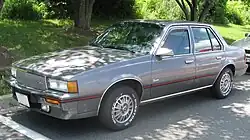


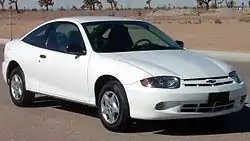
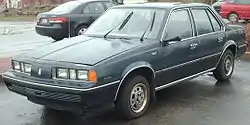
.jpg.webp)

.JPG.webp)
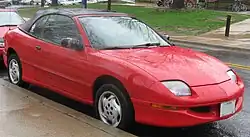
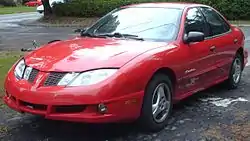
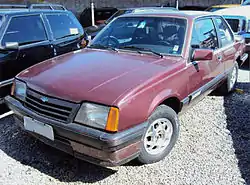

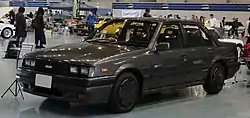
.jpg.webp)
